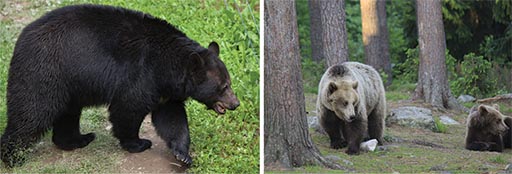1 Identity

The bears in Figures 1 and 2 look similar even though they are from different continents. Their common names refer to their colour. But that can be misleading as the fur colour of black bears (Latin name Ursus americanus) can be brown and similarly, brown bears (Ursus arctos) can have fur that is almost black. Both black and brown bears occur together in parts of North America. They are classified as separate species because, although hybrids have occasionally been found, the hybrids themselves do not appear to be fertile.
The term species is surprisingly difficult to define. A commonly used definition is the biological species concept, which defines a species as a reproductively isolated group of individuals that are able to breed together to form offspring that can in turn breed successfully. In later weeks you will come to realise the deficiencies of this definition, even though it is widely used.
Every species has a two-part scientific name – called a binomial – that identifies it uniquely. The first name indicates the genus (plural genera) to which the species belongs – i.e. the group of closely related species that are similar in appearance. For example, polar bears, are in the genus Ursus but pandas aren’t. The species name is the name given to the species when it was first discovered and described, and that name cannot be changed except in special circumstances. However, genus names are occasionally altered as more information on how species are related to each other becomes available. It sometimes happens that an organism is described and named by two people independently, in which case it’s the one that’s published first that is universally adopted. The name of a new species is published with a description of a specimen, giving the key features that define the species, so that other people can make a correct identification. That specimen is known as the type specimen and should be stored for future reference, preferably in a national collection.
